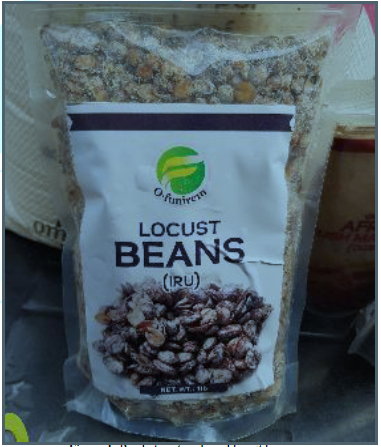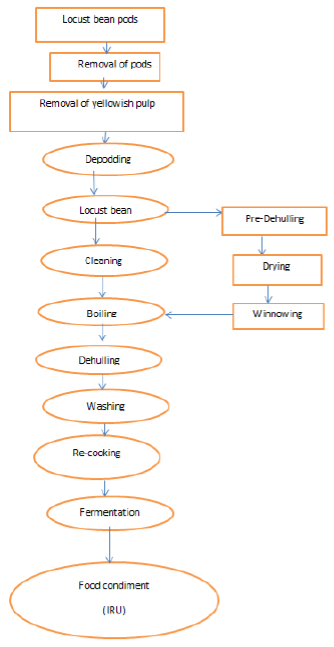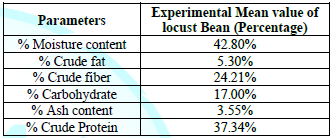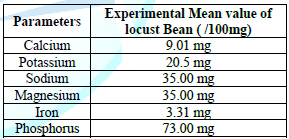Research Article :
Olalude CB,
Adegboyega AM, Bamigboye AY, Abiona DL, AnifowoseOA and Babatunde SY This study examined the nutritional properties
and industrial application of African locust bean properly known as Iru in
southwest Nigeria. Locust bean was processed into food condiment which is used
as a spice that gives an African meal a pleasant flavor. The production process
of locust bean includes boiling for 12 hours, soaking the seeds in water,
de-hulling, boiling for another 6 hours and ferment for 4 days. Proximate
analysis and mineral content of the African locust bean (Parkia biglobosa) fruit pulp was determined using standard methods
Association of Analytical Communities (AOAC) (1995). The results showed that African
locust bean contain 42.8% Moisture, 37.34% Protein, 24.21% Fiber, 0.9% Fat,
3.55% Ash, and 17.0% Carbohydrate using proximate Analysis. The Mineral
elements present are Calcium 9.01 mg/100 g, Potassium 20.5 mg/100 g, Magnesium
35.00 mg/100 g, Iron 3.31 mg/100 g, Phosphorus 73.00 mg/100 g with the use of
Atomic Absorption Spectrophotometer Analysis technique. With the values gotten
for the nutritional and mineral analysis of African locust bean, it should
therefore be substituted for Monosodium Glutamate (MSG) used industrially for
the production of various magi and flavorings which are not nutritive but are
carcinogenic chemicals while locust bean has no health side effect. The food
industry should package the locust bean in a way which would make the condiment
much more attractive to its consumer and non-consumers because is faced with
packaging problem. The African locust
bean
(Parkia biglobosa) is a multipurpose
tree legume that belongs to the family Mimosoidea of the Leguminosae. It
is found in many African countries it is green and dark brown when mature, it
grows in long slender pods when premature, it is often called Iru by the
Yoruba’s, Dawa-Dawa” by the Hausa, and “Ogiri” by the Igbos of Nigeria [1]. It is a medium-sized tree that reaches 20-30 m high.
It has a dense, widely spreading umbrella-shaped crown and a cylindrical trunk
that can reach 130 cm in diameter, it exudes an amber gum when cut. The leaves
are alternate, flower head is broad and it has a strong pungent smell. The
flowers are bisexual, sterile or nectar-bearing. The fruit is a linear,
glabrous and smooth and has indehiscent pod that becomes brown at maturity,
embedded in a yellowish mealy pulp. The seeds are globosely-ovoid, smooth and
glossy dark in colour and are hard coated and can remain viable up to 8 years [2]. The seeds that are used later to prepare the African
locust beans after been cooked and fermented before you can consume it or used
in our daily soups and stews. African locust bean is a black strong smelling
seasoning which is rich in fiber, protein, and carbohydrates. The seeds, the fruit pulp and
the leaves are used to prepare numerous foods and drinks, and to feed livestock
and poultry, hence, it is a very popular ingredient in traditional African
cuisines [3]. The beans help in boosting your immune system, relieve diseases
like diarrhea, diabetes and reduce the chance of heart attack. It is also used
as a remedy to counteract the effects of poison like snake bites and scorpion
stings. The bark of the African locust bean tree is also used as a vapor
inhalant to relieve toothache and ear
issues. It is also used as a remedy for leprosy,
bronchitis, skin disorders, sores, ulcers, malaria, hypertension, and many
sicknesses [4]. Locust can be used to treat the following health
issues; stroke, high cholesterol, diarrhea, hypertension, blood Sugar level,
indigestion, weight, Fever, Vision problems [5]. The seeds, pods, fruit pulp
and leaves are edible and used as cooking or drinking ingredients. The tree is
particularly valued for its ferment escible seeds. They
are fermented to prepare a condiment that is called "soumbala",
"dawadawa", "netetu" or "afinti" that is a
strongly pungent as French cheese. This condiment used for sauce and soup
seasoning is one of the most important commercial products traded in western
Africa. Ground with moringa leaves, the seeds are ingredients for sauces and
doughnuts. They can be roasted to make a coffee substitute known as "Sudan
coffee”. In locust bean mature pod, seeds are surrounded by a
quantitatively important mucilaginous pulp which
is separated from the seeds when they are collected. This mealy pulp is
traditionally consumed as fresh food by local African
populations. It makes valuable baby food and is
used to make a refreshing drink. The leaves can be boiled, mixed with cereal
flour and eaten as vegetable. Flower buds are edible and added to salads [2,6]. Fruit pulp, foliage and seeds of the African locust
bean can be used to feed livestock and poultry. The fruit pulp and the seeds,
once processed to remove anti-nutritional factors, can be included in livestock
feed. The leaves provide useful though not very palatable fodder. Their
usefulness is increased by the fact that they can be harvested during the dry
season when feed is scarce. However, it should be mixed with other feed because
their mineral content is too low. The flowers are attractive to bees and a good
source of nectar. The African locust bean trees are suitable for beehives [2]. The wood is used in light constructions, poles,
mortars, and many kinds of furniture and utensils. It is valuable firewood and
provides pulp to make paper. The bark has many traditional uses in
ethno-medicine. A root decoction is reported to treat coccidiosis in poultry.
Green pods are used as fish poison to catch fish in rivers. African locust bean
trees are used as ornamental. They are useful soil improvers and their leaves
provide green manure [6]. African is a blessed continent to have such a tree of
great importance because of the food and herbal benefits that is associated
with the African locust bean tree and by-product. It is a good source of income
for rural dwellers in Africa as everything within the African locust bean tree
is of great importance [7]. African locust beans have been used as a seasoning
and adding flavor in cooking soups and stews. It is boiled and fermented
through a process that requires continues boiling until is ready for
fermentation (see flow chat of locust bean production below). It has been put
on research and tested on rats to find the impacts and it is shown that it can
control blood pressure because it helps in reducing arterial blood pressure
when you eat the right quantity. It is also a good substitute to spicy or
seasoning cubes and contains enough mineral substances found in many plants. In the developing country like Nigeria, many people
may not be able to afford animal products which are rich sources of protein
because they are either too expensive or simply unavailable. Staple diets
consist mainly of cereal grains or starchy roots and tuber crops thus leading
to various health problems associated with protein and vitamin or mineral
deficiencies. In the search for plant protein and vitamin substitutes, the
African locust bean (Parkia
biglobosa) has found very popular especially in the fermented ‘iru’
form, which is a product of the seeds, however; the yellow dry powdery fruit
pulp has not attracted much attention. The main objectives of this study are · To
determine the nutritional properties. · Possible
industrial use of African locust bean. Sample
collection The raw African locust bean seeds were purchased
from Bodija, a local market in Ibadan, Oyo state,
South West Nigeria. All the reagents used were of analytical grade. Sample
preparation The seeds were sorted out, soaked in water, boiled
for 12 hours and further soaked the beans in boiling water for another 12 hours
overnight, excess water was drained off and the seeds were de-hulled by
marching the seeds by feet in a mortar and removal of the seed coat was done by
rubbing the cotyledon between the palms of the hand and washing with water. The
cotyledons were again cooked for another 6 hours, the boiled water was drained
off and the cotyledons were then spread into trays, covered and wrapped with
sacks and fermented for 4 days to produce locust bean. Analysis
and equipment used •
The physico-chemical
analysis was done using standard methods described by (AOAC
1995) to determine the following parameters, moisture content, crude fiber,
protein, fat, moisture content, ash content, carbohydrate [8]. •
Atomic Absorption Spectrophotometer was
used to determine the mineral contents of the sample (locust bean) (Figure 1 and Figure 2). Figure 1: Ready to eat packaged locust bean. The Proximate analysis of the African locust bean
that was analyzed is: Moisture content, Ash content, Carbohydrate, Crude fat,
Crude protein and Crude fiber. Potassium, calcium, magnesium, iron and
phosphorus were analyzed using Atomic Absorption spectrophotometer equipment. Figure 2: Flow chart for traditional processing of locust bean to food condiment. Table
1:
The African locust bean had high value of Protein (37.34%), protein helps to
build the body for proper body growth and is in agreement with the finding of Uwaegbute
(2006) [9]. The level of crude fiber was high 24.21% which is considered
advantageous since high fiber contents are desirable in meal, as they aid
digestion easily, and known to be most effective in maintaining human health
such as reduction in body weight, reduction in stroke incidence and good heart
health, it is also a source of dietary fiber which is essential for good bowel
movement and helps in preventing obesity, diabetes, cancer of the colon and
other ailments of the gastro-intestinal
tract of man. The value is much higher than most food
legumes, which range from 2.10% in groundnuts to 7.60% in kidney beans [10].
This makes the African locust bean is a good source of dietary fiber. Carbohydrate content was found to be 17.0% it is in
agreement with the value of Olalude et al [10] with this content of
carbohydrate, the African locust bean is a potential good source of energy,
Though proteins and fats also provide necessary energy, carbohydrates are much
cheaper and more easily digested and absorbed. The ash content present
indicates that it is a good source of macro and micro elements. The content of
3.55% is within the range for most legumes of 2.00% in pea to 5.00% in soya
bean; this is an indication that the African locust bean is a potential good
source of minerals required by the body. Crude fat was found to be 5.30%, this is in
conformity with most legumes, which apart from groundnuts (45.30%), soybeans
(17.70%) and winged bean (17.00%), and all have less than 3.00% fat with
lentils having as low as 0.60% [11]. It is also reported a fat content of 0.50%
for Mediterranean
locust bean (Ceratonia
siliqua) fruit pulp. This low fat content is an indication that locust
bean can be stored for long periods at the right temperature and moisture
without spoilage by rancidity, which is characteristic of many legumes. Table 1:Proximate analysis of African locust bean. Table
2:
Mineral elements such as Potassium 20.5 mg, Sodium 35.00 mg, and Calcium 9.01 mg,
Phosphorus 73.00 mg,
Iron 3.31 mg and Magnesium 35.00 mg were obtained from the experimental
analysis and were of appreciable amount. Calcium, Magnesium and Phosphorus are
important for bone formation and its maintenance. High potassium concentration
with low sodium level are intracellular and extracellular cations of importance,
they perform specific functions in cellular metabolism, modulation and
signaling. Table 2: Mineral content of the African locust bean. The production of locust bean offers a means of
utilizing it as a food. African locust bean contain essential nutrients needed
for the growth and development of the body. The liberal use of this condiment
is expected to increase the intake of these essential dietary components
appreciably. In addition, the presence of high level of ash and fiber content is
an added advantage over seasoning salts, which can cause cancer. Iru should be substituted to Monosodium
Glutamate, because it has been found to have no side effect
on the health of humans. African locust beans should be used during cooking of
soups or other food instead of the varieties of magi which contain MSG. Christianah Olalude, Department of
Chemistry, The Polytechnic, Ibadan, Nigeria, E-mail: olaludechristianah@gmail.com
Olalude CB, Adegboyega AM, Bamigboye AY,
Abiona DL, Anifowose OA, et al. Proximate analysis and mineral content
determination of traditionally processed locust bean (Parkia biglobosa) fruit pulp for possible industrial application
(2021) Edelweiss Chem Sci J 4: 10-13. Nutritional, Locust bean, Proximate, Mineral,
IndustryProximate Analysis and Mineral Content Determination of Traditionally Processed Locust Bean (Parkia biglobosa) Fruit Pulp for Possible Industrial Application
Abstract
Full-Text
Introduction
Justification
Objectives
Material
and Method

Results

Discussion


Conclusion
References
Corresponding
author
Citation
Keywords